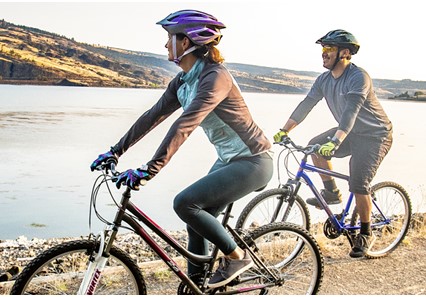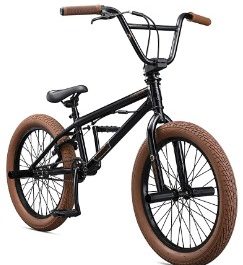Bike helmets come in different colors and shapes, but most have a common trait, the presence of holes. We often overlook this common trait, but have you ever wondered, ‘why do bike helmets have holes?’
There is no doubt that bike helmet holes play a crucial part. Though some assume it’s a manufacturer’s design, bike helmet holes are essential for ventilation (keeping you cool) and reduces wind noise.
But doesn’t riding a bike without a helmet keep you even cooler? While this is true, it keeps you at great risk of increasing injury during falls or accidents.
This guide will take you through why bike helmets have holes, how many holes should be in your bike helmet, what to do if your bike helmet has no holes, the limitations of bike helmet holes, and the importance of bike helmets.
Tag along!

Why Do Bike Helmets Have Holes? 2 Reasons Explained!
Below are two reasons why bike helmets have holes:
1. For Proper Ventilation
Cycling is an intensive exercise that requires energy. That creates heat which makes you sweat despite the weather. Bike helmet holes are handy here; they let the sweat evaporate, enabling you to stay cool and focus on your ride.
Since it’s two-way traffic, the holes allow hot air from the inside to escape and cool air from the outside to get inside, ensuring your head remains cool.
2. They Reduce Wind Noise
When cycling at high speed with a helmet without holes, chances are that wind will cause noise, a major disturbance when riding your bike.
What about a helmet with holes?
Holes in the helmet allow wind to pass through and reduce friction, giving you an enjoyable, noise-free ride. Also, it enhances your on-road concentration and thus reduces the chances of falling or causing an accident.
How Many Holes Should Be There in Your Bike Helmet?
Though all bike helmets must meet the safety standard, there is no regulation on how many holes a helmet should have. However, the more holes, the greater the ventilation, while the opposite is also true.
It’s also good to note that the number of holes differs from manufacturer to manufacturer. Another determinant of how many holes a bike helmet should have is the bike helmet type.
For example, while road bike helmets come with more holes and give you more aeration, mountain bike helmets have fewer holes.
Though we cannot say precisely the number of holes each helmet should have, you will likely get most helmets averaging 15 – 18 holes. Nevertheless, helmets with ten holes are termed ventilated helmets.
What If Your Bike Helmet Has No Holes? What to Do:
Now, sometimes you may buy a helmet that does not share the same trait as others (lacks holes). If this is your case, how can you ensure you wear your hole-less helmet and remain cool?
Below are some of the things you can do to compensate for your hole-less bike helmet:
- Wearing Light Clothes
It’s worth noting that a bike helmet with no holes will overheat, making you sweat profusely, and your sunglasses will fog, affecting your visibility.
However, to avoid such a scenario, you can put on light clothes that have the wicking ability when going on a ride. They prevent sweat from building up, and they ensure you remain cool.
One such piece of clothing is the Sponeed Cycling Jersey (Check on Amazon). It is breathable and elastic and offers excellent ventilation.

- Drinking Lots of Water
Water is good for your health. Doctors recommend eight glasses of water every day. On a ride with no holes in your helmet, you can reduce the heat by drinking much water as it will help keep your body temperature moderate.
So, pack enough water before commencing your ride and sip the water as you ride instead of drinking when you get thirsty.
- Choose Your Cycling Time Wisely
Choose a duration when the sun is not scorching hot. That is because the hot weather will leave you feeling hot, sweaty, and even miserable.
So, riding with no holes in your helmet calls for choosing wisely the time to ride your bike. That can be early mornings, evenings, or nights or when it’s cold as the weather is more favorable.
Limitations of Bike Helmets with Holes
Despite being advised to have a bike helmet with holes, some downsides come with bike helmet holes. They include;
- Increased Level of Injury
Holes weaken the structure of the bike helmet, thus compromising the ability to fully protect your head during a fall or crash. Some harmful materials may get through the holes when one falls, leading to injuries.
So, when using a helmet with holes, you should be extra cautious to avoid accidents or falls. That’s why off-road riders prefer full-face helmets without holes.
- Hampers airflow
During the cold season, one must cover his body as much as possible. But this is unachievable if you use a bike helmet with holes.
This can lead to one getting cold-related diseases which sometimes can worsen if you continue cycling in the cold.
Importance of Bicycle Helmet
Most times, one may wonder, is wearing a helmet when riding a bike necessary? The following are a few reasons why a bike helmet is essential.
- It prevents injuries
Helmets are vital in preventing the rider from severe head and facial injuries. A helmet protects your head from direct contact with unsafe surfaces during a fall or a crash.
However, for more protection, you should wear the right size helmet that fits properly. This way, you will protect your brain and head from external injuries or internal bleeding.
- Improving visibility
bike helmets, especially one with a visor option, help increase rider’s visibility? That is because riders can ride in any given condition.
For example, during wind season, dust may harbor your vision, but with a visor on, it protects you, ensuring you remain focused.
- Easy identification
Most bike helmets come with reflective lights or strips that help motorists and other road users to identify the rider from afar. That is usually helpful at night. The best part is that it helps in reducing accidents.

People Also Ask
1. Why Do Bicycle Helmets Have Holes?
As seen, bicycle helmets have holes to give you proper ventilation and reduce wind noise. The holes allow cold air from the outside to flow to the inside, keeping you cool throughout your ride.
2. Do All Bicycle Helmets Have Holes?
Not all helmets have holes, and some have, others don’t. However, those that have also differ in the number of holes. Some have more, while others have less.
However, bike helmets’ average number of holes ranges from 15 – 18 holes. Still, there are some with ten holes.
3. How Does a Helmet Protect Your Head?
Helmets have a technology that helps to reduce impulsive force during any accident. It reduces the impact between your head and the contact surface.
4. Why Are Helmets Important?
Bike helmets protect your head from severe head injuries during falls and accidents.
Also, they increase your on-road visibility, especially those with a visor, as they protect your face from harmful weather elements like the scorching sun, wind and dust, and rain.
In conclusion, why do bike helmets have holes?
As seen, bike helmet holes come with immense advantages. For one, the holes give you proper ventilation and reduce wind noise.
But since the number of holes differs, you can choose according to your needs. However, the helmet’s holes may increase your injury level when you fall or crash. So choose wisely.

